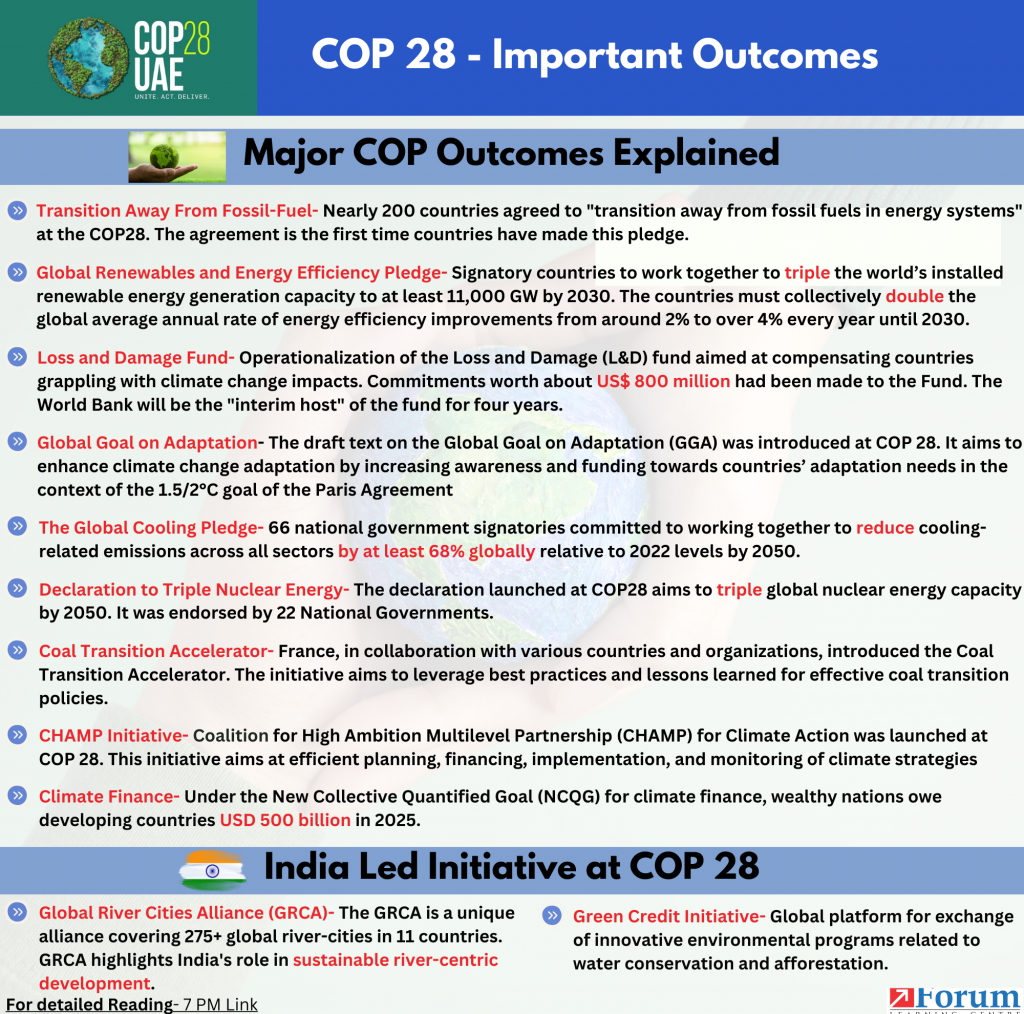ForumIAS announcing GS Foundation Program for UPSC CSE 2025-26 from 19 April. Click Here for more information.
ForumIAS Answer Writing Focus Group (AWFG) for Mains 2024 commencing from 24th June 2024. The Entrance Test for the program will be held on 28th April 2024 at 9 AM. To know more about the program visit: https://forumias.com/blog/awfg2024
Recently, Conference of Parties 28 (COP 28) to the United Nations Framework Convention on Climate Change (UNFCCC) was concluded in Dubai, UAE. The COP 28 climate meeting delivered some important outcomes. However, like all previous COPs, it still remained an underachiever, particularly in galvanising more ambitious climate action in the immediate term.

| Table of Contents |
| What have been the positive outcomes of COP-28? What are the Shortcomings of COP 28? What Should be the Way Forward? |
What have been the Positive Outcomes of COP-28?
1. Global Climate Stocktake- Based on the global stocktake review at COP28, countries would be required to submit raised emissions reduction targets by mid-2025 for finalisation at COP30. This stocktake can guide our future climate action.
2. Operationalisation of Loss and Damage Fund- The operationalisation of the fund will help in ensuring climate justice to the developing and underdeveloped countries which have suffered tremendous loss and damage due to climate change.
3. Fossil fuel role in Climate Change- In COP-28, the role of fossil fuels in causing global warming has been formally acknowledged for the first time. Fossil fuels which contribute to 75% of all greenhouse gases and about 90% of global carbon dioxide (CO2) emissions, took centre stage at COP28. This marks the beginning of the end of fossil fuel usage in the world.
4. Phase-down of coal- The COP-28 document singles out coal amongst other fossil fuels by calling for phase down.
5. Emission reduction with enhanced focus on renewable energy- The Global Renewables and Energy Efficiency Pledge, adopted at COP 28, has the potential to avoid emissions of about 7 billion tonnes of carbon dioxide equivalent between now and 2030. This reduction of emissions will be more than the combined emission reduction due to all the other climate actions being currently taken.
6. Increased Focus on Adaptation- COP 28 resulted in the identification of some common adaptation goals, which are important for the entire world. Before COP 28, adaptation measures had largely been a local endeavour.
7. Need for enhanced Climate Finance- The COP 28 conference also highlighted the need for enhanced climate finance to combat the climate change consequences. According to the report by UNCTAD, wealthy nations owe developing countries USD 500 billion in 2025 under the New Collective Quantified Goal (NCQG) for climate finance.
8. Diverse participation- The COP 28 saw the participation of activist groups, indigenous groups, big and small business, consultancies, traders and media. These diverse groups enhance the transparency of the Climate change negotiations.
| Read More- Loss and Damage Fund- Explained Pointwise |
What are the Shortcomings of COP 28?
1. Lack of Ambitious Climate Action- Despite the various pledges, no binding ambitious climate action was launched.
2. Issues with the Fossil Fuel Pledge- No time schedules and targets have been fixed for the phase out of fossil fuel.
3. Issues with the Renewable Energy Pledge- Under the pledge, tripling of global renewable energy has been made a global target. However, there is no clarity as to how this would be achieved as no binding individual targets were made.
4. Issue with Phase Down of Coal Usage- COP 28 failed to resolve the impasse over the proposal that no new coal-fired power plants could be opened without an in-built carbon capture and storage facility.
5. Impasse over Methane Emission Cuts- Several countries, including India, are extremely opposed to any binding commitment to cut methane emissions. Cutting methane emissions could involve tweaking agricultural patterns, which could pose concerns for food security in developing countries like India.
6. Lack of Financing Mechanism- COP 28 has failed to set up a financial mechanism to finance the Global Goal on Adaptation. The Draft of COP 28, did not express any concern over the failure of commitment on developed nations to provide $100 bn climate finance per year by 2020. The loss and Damage funding has been made voluntary.
7. Misuse of the loose definitions in the COP 28 Draft- The inclusion of the terms like “low-carbon fuels”, “low-emission” technologies, “low-carbon hydrogen”, and “transitional fuels”, can be misused by the EU and US as they use these terms to describe natural gas. Natural gas is a major fossil fuel and contributes to global warming and climate change.
8. No mention of CBDR- The term Collective But Differentiated Responsibilities (CBDR) and Polluter’s pay principle have been missing from the draft of the COP 28.
What Should be the Way Forward?
Though the COP-28 has introduced new goals and pledges, substantial follow-up actions need to be undertaken to fulfil these goals.
1. Introduction of New Indicators- New tangible indicators need to be identified to measure progress on each of the global goals established at COP 28.
2. Establishment of Financial Mechanism- Financial mechanism to raise $500 bn as estimated by the UNCTAD must be established at the earliest. Developed nations must not be given leeway to cut down on their financial obligation.
3. Binding commitments– Efforts must be taken to make the renewable energy pledges binding on all the member countries.
4. Clarity on phase down of Fossil Fuel- Clarity on the timeline and targets for fossil fuel phase down must be on the highest agenda of the future COPs.
5. Climate Justice- Common but Differentiated Responsibility (CBDR) must remain the guiding light in upcoming climate negotiations.
| Read More- Indian Express UPSC Syllabus- GS 3- Climate Action and Climate Change, Conservation |




